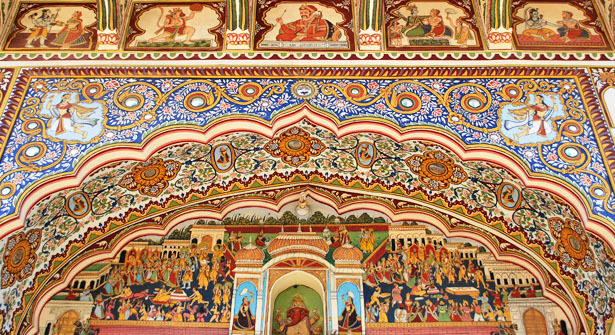The princely state of Rajasthan has a long history of Rajputs, land acquisitions, battles won and fought, sprawling palaces, and rich mansions. The state has been often described by an onlooker as a dream carved in marble. The arid desert topography is in sharp contrast to the colorful life that is prevalent here. Each region in Rajasthan specializes in some thing or the other. Fresco wall paintings of Shekhawati are unique in themselves, although it was the Mughal kings who made murals fashionable, their religious indictments forbade them from having man or animal as motif; they were allowed only floral and abstract designs. To an extent this posed as an obstacle. Wall painting in Shekhawati boomed only after Mughal power was declined. For the early corpus, the artists depended heavily on traditional Indian subjects. This consisted of scenes from mythology, especially of Lord Krishna, local legends, animals and plants, daily lives of men and women, towns and the Shekhawat Rajas. Most of the towns are good enough to see classic fresco wall paintings, few are Mandawa, Ramgarh, Fatehpur,
Nawalgarh, Bissau, Dundlod, Alsisar etc. The havelis in Shekhawati region are beautifully painted and frescoes abound here. The interiors, pillars, rooms, halls all has been designed with the most intricate of Frescoes. For coloration these craftsmen used vegetable dyes. Floral motifs and arabesque poses were the regular themes. The fresco painting artists were called chiteras, who belongs to the kumhars (potters) caste. They are also called chejaras (masons) since they works both as painters and builders. The paintings were depicted in bright two-dimensional paintings. The chejaras used only natural colors for their art, like kajal (lamp black) for black, safeda (lime) for white, neel (indigo) for blue, geru (red stone powder) for red, kesar (saffron) for orange, pevri (yellow clay) for yellow ochre and so on. Mixed in limewater and beaten into plaster, they remained vibrant for almost as long as the building lasted.
The havelis earned their splendour through backbreaking effort. Mural painting was an elaborate process, involving different materials, layers and techniques. Scenes depicted cover 10 broad themes—decorative designs, daily life, religion, raga mala, folk mythology, historical events or personalities, flora and fauna, erotica, maps or places, and the British and their contraptions. Most chhatris or domes include a rasamandala in the ceiling—a dancing circle in which Krishna miraculously replicates himself so each Gopi finds him dancing next to her.
Besides popular love stories such as Laila–Majnu and Heer–Ranjha, Shekhawati’s murals have a recurrent theme of a couple astride a camel portraying Rajasthan’s most popular romantic tale—Dhola–Maru. Married off as kids, Dhola returns as an adolescent to fetch his wife. En route, they encounter bandits Umra–Sumra, and like a true Rajput wife, Maru repels the attackers while Dhola urges his camel onwards. Paintings also represent lesser-known folk tales of Binjo–Sorath. Binjo mesmerises his young aunt Sorath with his veena as she dances to his tunes. Sassi–Punu recounts the legend of Punu, a prince who weds Sassi, an abandoned princess raised among washermen. Tragically, Punu is kidnapped and Sassi dies in search of him in the desert.
The colours –
Before the 19th century, artists used natural colours such as lampblack, and red, green and yellow ochres. Lime was a substitute for white and was used for lightening other hues, while indigo, ultramarine, vermilion, verdigris, gold and silver were reserved for prayer rooms and bedrooms. The Indian Yellow, made from gomutra or urine collected from cows fed on mango leaves, was used, albeit rarely. In 1860, German chemical pigments such as ultramarine, chrome red and emerald green reached India and remained popular till World War I, until supplies were hit. (Inspired by ‘Made in Germany’ paint tins, many painters randomly emblazoned the word ‘Germany’ to depict anything English!) Maroon was popular from 1820 to 1865, red and blue held sway between 1860 and 1910, and multi-coloured paintings using cheap European paints dominated the years from 1900 to 1950.
However, the best way to ensure a hassle free and great tour is to get it from a tour operator which has a high level of expertise and experience in this sector. We are a leading tour operator company. Visit our website and book customize tour packages as per your demand. We never compromise in our service.
Here are some our Best tour packages for Shekhawati Rajasthan Choose them any and explore the rich culture of Rajasthan with us.
Shekhawati Tour Packages
Rajasthan Luxury Tour Packages
Vehicle rental Packages For Rajasthan Visit
